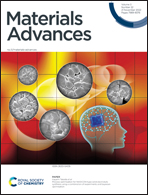Optimization of spray-coated nanochitin/nanocellulose films as renewable oxygen barrier layers via thermal treatment†
Abstract
The demand for food and pharmaceutical packaging materials is increasing, but the most common materials used are non-renewable, non-biodegradable petroleum-based plastics, which has resulted in many end-of-life problems. Cellulose nanocrystals (CNCs) and chitin nanowhiskers (ChNWs) have high strength and low oxygen permeability (OP), providing a renewable alternative. In this work, we spray coated ChNWs and CNCs on cellulose acetate (CA) film and tuned the film properties by adjusting the spray coating temperature (Tspray) and the post thermal treatment temperature (Tthermal). Importantly, by increasing Tspray (from 40 to 100 °C) and Tthermal (from 40 to 140 °C), the OP decreased 48% and 62%, respectively. The optimal OP (i.e., 11.5 cm3 μm m−2 day−1 kPa−1) is comparable to that of commercial oriented poly(ethylene terephthalate). Film transmittance and haze were dependent on both temperatures, with higher Tspray and Tthermal giving rise to coated films with lower haze and higher transmittance values approaching those of bare CA. The mechanical properties and water vapor barrier properties of the coated films were on average 20% and 11% enhanced compared to neat CA, without being significantly influenced by the temperatures. These properties support the use of the polysaccharide-based film as a renewable substitute in packaging applications.

- This article is part of the themed collection: Biomass Materials


 Please wait while we load your content...
Please wait while we load your content...